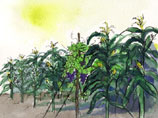
 With blistering summers, bitterly cold winters, persistent humidity and mildew problems, as well as deadly 2,4-D spray, it’s a wonder that anyone considers growing grapes in Nebraska. Prohibition erased almost all of the state’s 5,000 acres under vine, and by the start of the 1990s, fewer than 10 acres remained. Nebraska’s oldest existing winery only began in 1994, although growth has been rapid and more than 20 others have opened since. These wineries are spread across the state, from the sandy hills of western Nebraska to the rolling hills and rivers of the southeast. These small producers sell most of their product at the farm gate to vineyard visitors. Many foresee great economic spinoffs, resulting from an increase in wine-related tourism. The industry is very progressive, with an active Nebraska Winery and Grape Grower Association and a viticulture program at the University of Nebraska. These bodies have conducted grape growers’ educational forums since 1998, growing from 40 participants initially, to 260 in 2002. Watch out, corn!...here come the grapes!
With blistering summers, bitterly cold winters, persistent humidity and mildew problems, as well as deadly 2,4-D spray, it’s a wonder that anyone considers growing grapes in Nebraska. Prohibition erased almost all of the state’s 5,000 acres under vine, and by the start of the 1990s, fewer than 10 acres remained. Nebraska’s oldest existing winery only began in 1994, although growth has been rapid and more than 20 others have opened since. These wineries are spread across the state, from the sandy hills of western Nebraska to the rolling hills and rivers of the southeast. These small producers sell most of their product at the farm gate to vineyard visitors. Many foresee great economic spinoffs, resulting from an increase in wine-related tourism. The industry is very progressive, with an active Nebraska Winery and Grape Grower Association and a viticulture program at the University of Nebraska. These bodies have conducted grape growers’ educational forums since 1998, growing from 40 participants initially, to 260 in 2002. Watch out, corn!...here come the grapes!
|
|
Current Feature
In the southern Blue Ridge Mountains of North Carolina and Georgia vineyards are small and few, yet the establishment of the Upper Hiwassee Highlands could bring much more.
[>] continue
Related Features
Alive & Well here

Edelweiss:
You are part of a band of Native and French-Americans that could easily be called the ‘Polar Bear Gang’.
[>] continue
